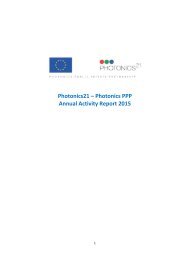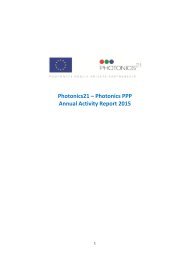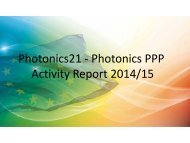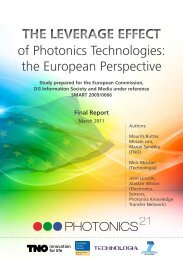Towards 2020 – Photonics driving economic growth in Europe
Create successful ePaper yourself
Turn your PDF publications into a flip-book with our unique Google optimized e-Paper software.
2. <strong>Photonics</strong> Research and Innovation Challenges<br />
53<br />
this hurdle. In order to implement quickly the results<br />
of the <strong>Photonics</strong> PPP, the EU Commission should<br />
consider establish<strong>in</strong>g a revolv<strong>in</strong>g fund with the<br />
participation of the <strong>Europe</strong>an Investment Bank,<br />
targett<strong>in</strong>g the fast followers.<br />
OLED light <strong>in</strong>stallation<br />
Supernova on designer platform<br />
lab.me. © OSRAM GmbH<br />
The recommendations of the task force on SSL for<br />
Cities, established by the EU Commission with<strong>in</strong><br />
the framework of the SSL Green Paper ‚Light<strong>in</strong>g<br />
the Future’, will be highly <strong>in</strong>strumental <strong>in</strong> speed<strong>in</strong>g<br />
up the uptake of <strong>in</strong>telligent LED based light<strong>in</strong>g <strong>in</strong><br />
the public doma<strong>in</strong>.<br />
OLEDs (for light<strong>in</strong>g)<br />
In terms of technological maturity, OLEDs lag beh<strong>in</strong>d<br />
LED technology, and consequently OLEDs<br />
are faced with an LED-dom<strong>in</strong>ated market. The<br />
penetration of such a market will strongly depend<br />
on the OLED’s ability to outperform LEDs <strong>in</strong> two<br />
areas; cost performance and the new market opportunities<br />
offered by large area and flexible light<br />
sources. Material suppliers will be highly <strong>in</strong>strumental<br />
<strong>in</strong> achiev<strong>in</strong>g the required cost performance<br />
breakthroughs, as well as for develop<strong>in</strong>g efficient<br />
blue light emitters and more efficient OPV layers.<br />
These cost performance issues can only be addressed<br />
effectively by mak<strong>in</strong>g the transition from<br />
‘lab to fab’. Only when pilot l<strong>in</strong>es are deployed,<br />
will it be possible to assess the full potential offered<br />
by this technology. The highest throughput<br />
and lowest costs come through the use of sheet to<br />
sheet (S2S), roll to sheet (R2S), or roll to roll (R2R)<br />
processes, together with photolithography or laser<br />
ablation. Materials represent a major contribution<br />
to the cost of OLED products, and this dictates that<br />
effort be focused on production processes with low<br />
levels of material utilisation.<br />
Flexible OLED. © Holst Centre<br />
OLED pilot production l<strong>in</strong>e<br />
<strong>in</strong> Regensburg, Germany.<br />
© OSRAM GmbH<br />
In laboratory conditions, limited size flexible OLEDs<br />
have been realised on metal and plastic substrates.<br />
Now it is necessary to scale up fabrication to the<br />
pilot l<strong>in</strong>e level, allow<strong>in</strong>g a realistic assessment of<br />
their market potential to be made.






